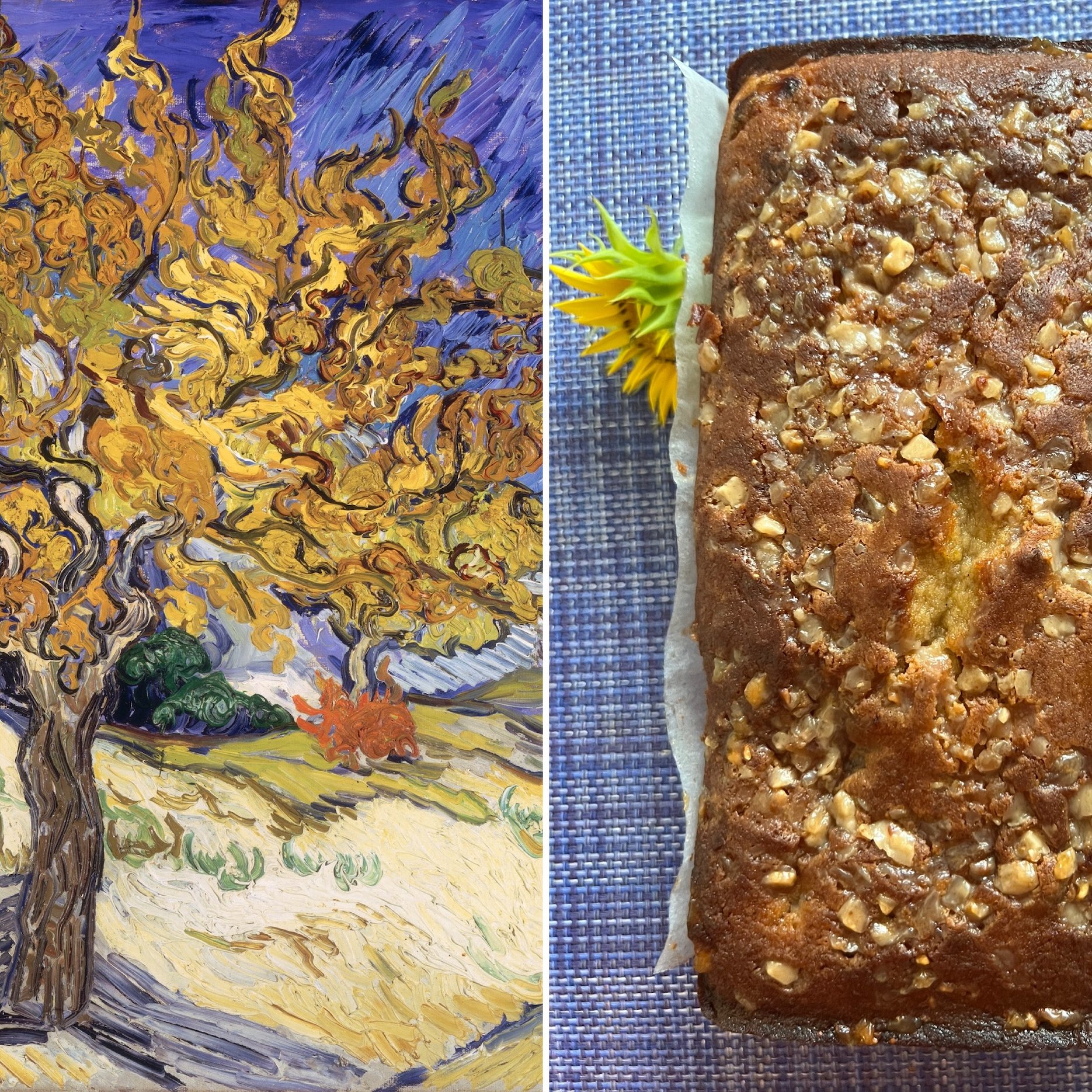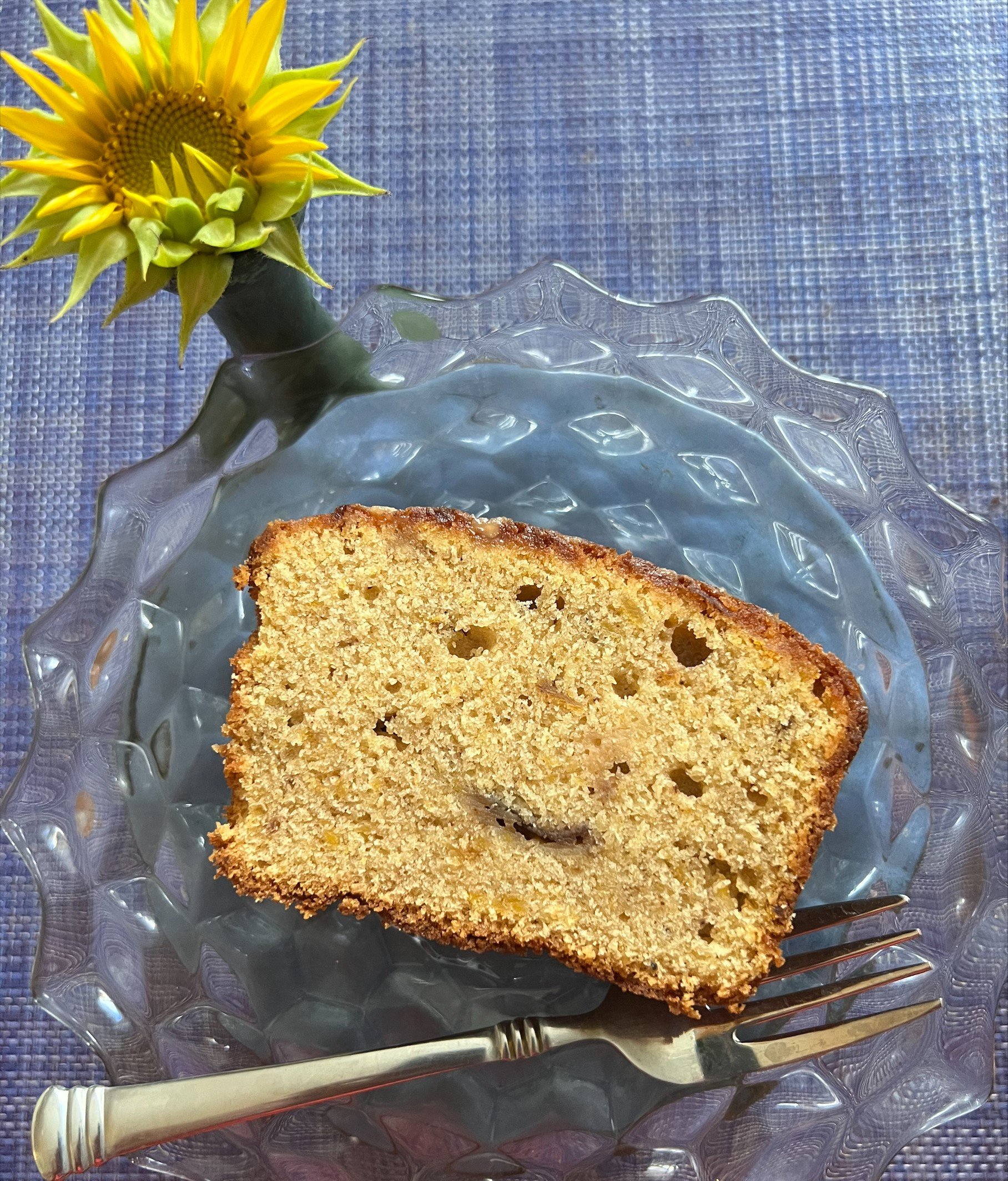Professor Butter Beard and Van Gogh’s “Mulberry Tree in Autumn”
“If a year was tucked inside of a clock, then autumn would be the magic hour.” - Victoria Erickson, writer
My friend Mary asked me “what magic are you baking this weekend?” I initially laughed and then the question lingered in my mind as I poured my coffee into a portable mug and harnessed up Nellie for a sunrise hike. The daybreak air was crisp and especially refreshing after the back-to-back heat waves throughout August. Nellie barked hello to a buck and his breakfasting family and then it happened. A single golden leaf fell from the sky. Nellie and I followed its swirling downward ballet until it landed softly at our feet. Of course, Nellie ate it in one bite and looked up with a giggling smile. I smiled back knowing that the autumn magic hour had begun.
You all must know by now that I can discuss Vincent van Gogh during any season. But, for me, his colors speak their own most gorgeous language in the fall. Sunflowers, wheatfields and vineyards all glow in his golden light. And then there is his mulberry tree – the perfect impression of autumn captured in highly-textured oil paint and brought alive by the master.
Van Gogh painted “The Mulberry Tree in Autumn” in October of 1889, less than a year before his death. Earlier that year, following a passionate fight with his fellow artist Gauguin and partial severing of his left ear, Van Gogh admitted himself into the Saint-Paul-de-Mausole asylum in Saint-Rémy to rest and heal. He wrote to his brother Theo describing “moods of indescribable anguish, sometimes moments when the veil of time and fatality of circumstances seemed to be torn apart for an instant.”
Saint-Paul was a former monastery in Saint-Rémy, located roughly twenty miles outside Arles, and run by a former naval doctor, Théophile Peyron. Van Gogh lived within two cells with barred windows, one of which he used as a studio. The constant in the artist’s life was painting and the clinic and its garden became the main subjects of his paintings. He captured all aspects of his life: the doctors, the hallways, the flowers in the gardens, the wheat fields, and the trees.
An aged mulberry tree grew in the central garden of the asylum. Van Gogh centered it in his canvas, growing alone alongside a rocky hillside. The ground is made up of short quick brushstrokes of white and pale browns contrasting the dark greens and browns of the mature tree trunk. The autumn leaves of the tree make up the majority of the painting, curling spirals of brilliant oranges, yellows and gold against the complementary color of the magnificently blue sky.
He wrote, “I should one day like to show by my work what such an eccentric, such a nobody, has in his heart. That is my ambition, based less on resentment than on love in spite of everything, based more on a feeling of serenity than on passion. Though I am often in the depths of misery, there is still calmness, pure harmony and music inside me.” That is his magic.
So yes, Mary, I did create a bit of weekend magic. I wove a culinary spell with the first butternut squash of the season, ripe figs picked by my friend Jason, fresh eggs from my favorite farmers and warming spices gathered from all my journeys. Toffee bits sparkle on the crust like a giggle from Nellie as she inhales the first fallen leaf of autumn. Bake all three loaves and enjoy a late afternoon fall picnic with friends. The magic hour has arrived.
Roasted Squash, Fig and Toffee Pound Cakes
Three loaf pound cakes
1 large butternut squash, peeled, seeded, diced, roasted and mashed (you will need one cup mashed squash for this recipe – save the rest for muffins or ravioli)
4 ½ cups all-purpose flour
1 Tbsp baking powder
1 Tbsp fine sea salt
1 Tbsp ground cinnamon
2 tsp ground ginger
½ tsp ground cloves
12 ounces unsalted butter (three sticks), room temperature
2 cups granulated sugar
1 cup dark brown sugar
6 large eggs, room temperature
2 tsp vanilla paste
1 cup buttermilk
½ cup plain Greek yoghurt
1 cup diced fresh figs (or plumped raisins, roasted nuts, or even mini chocolate chips)
½ cup chopped toffee pieces (I use Heath Bar bits)
Syrup:
¾ cup water
¾ cup granulated sugar
2 cinnamon sticks
1 star anise
1) Preheat your oven to 400 degrees. Peel and seed a large butternut squash. Cut it into 1” pieces, toss with olive oil and salt/pepper and roast on a parchment-lined sheet pan for 40 minutes until browned and soft. Cool for ten minutes and then mash with a potato masher. Set aside one cup for the pound cakes.
2) Butter and parchment-line three loaf pans
3) Cut the figs into a small dice and set aside.
4) Whisk together the buttermilk and yoghurt and set aside
5) Whisk together the dry ingredients and set aside
6) In a standing mixer, cream together the butter and sugars until light and fluffy (about five minutes). On medium speed, add the eggs, one at a time, until the mixture is smooth. Mix in the vanilla paste. Add the one cup squash and mix to combine.
7) On low speed, add 1/3 of the dry mix, then half of the buttermilk mixture, another 1/3 of the dry and then the remaining buttermilk mixture.
8) Remove the bowl from the mixer. Add the remaining dry mix and the figs and fold the mixture together with a spatula.
9) Divide the batter between the three loaf pans. Sprinkle the toffee pieces over the batter.
10) Place the loaf pans in the oven and then immediately reduce the temperature to 350 degrees. Bake for one hour until the top is just firm and the sides are starting to pull away from the pan. Remove the loaves to cool (in their pans) on a wire rack.
11) While the loaves are baking, add all the syrup ingredients together in a small pan and bring to a simmer on medium heat. Remove from the heat and let cool to room temperature. After the loaves cool fifteen minutes, brush the syrup onto the loaves.




